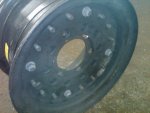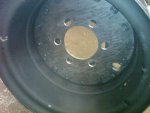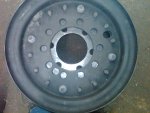I designed and built this same conversion over a year ago. I do not have my exact figures in front of me. I do remember, the wheels at my shop having almost a 1/4 inch of possible misalignment. Not exactly 1/4 but very close.
No, .040 is nowhere near .250 . The holes in the top part are .855, the studs are .750. The holes in my plate are .800 You have to add the possible misalignment of the back plate to the compounded misalignment of the top plate off of true center. That is the shock load that the deuce studs receive.
Huh, shock load. Its cushioned by a big air filled tire.Their is nothing holding the top plate centric. It is cushioned by the rubber o-ring.
The wheel top and bottom center themselves as it draws down on the o-ring.It still moves on the bottom plate. These wheels were originally designed to be center centric. That part of the design is cut off to make room for the conversion. So, something has to be put back into place to correct that flaw.
The .040 of play in just the back-plate alone (not even taking into consideration the possible play of the top plate) is more than enough play to sheer the studs on an axle.
Are you saying that being out of round .040 will shear the axle studs off a truck with the lugs tight? I'm not even going to argue that nonsense.
The two plates are bolted together with flanged nuts. It doesn't matter if they are torqued to the correct spec, they will not stop lateral movement of the plates. You must have a tapered designed nut to stop that. The plates are going to constantly misalign as the truck goes down the road.
I know for a fact that a flanged nut on a wheel that is non-centric does not work.
Again, wrong. Works great on my F-250. It is hub-centric, with flanged nuts. My sister in law had a horse trailer custom built by a large trailer manufacturer. They delivered the trailer(about 50 miles). The trailer was loaded for the show. With all new wheels the lugs should be re-tightened in short intervals. So, I torqued the lug nuts(to the stated spec.) before she left. They were loose. I did not take the time to look at the design of the hub and wheel. She left Athens, Ga. and just as she crossed the South Carolina line on I-20 she noticed her wheel in the other lane. Once stopped, all of the studs were sheered on that hub. The wheel behind it was loose and missing studs. All of the other wheels were loose. So, I had to drive to South Carolina to pick up 7 horses. Luckily no one was hurt. miraculously, the wheel rolled to a stop without hitting anything
Glad to hear no one was hurt.
Here is what they had done. They installed a 19.5 center centric 8 lug /5/8 bore wheel on a non-centric 8 lug /5/8 stud hub with flanged lug nuts. The tolerances between the stud and bore were far tighter that .040.
Really? Far tighter than .040. So maybe.015. That's roughly 2 human hairs clearance on each side of the lug. That's pretty snug. The manufacturer claimed that the design they put on the trailer was safe, until they had it delivered back to the plant. Their tuned changed. Come to find out they had just purchased these axle-wheel packages. This was the first trailer they had installed it on. They were glad that we had found the flaw before they sent out a bunch of trailers. They corrected the problem with the axle/wheel and added a few nice features to her trailer for free.
I want you to know, I like your product. I am not knocking it at all. Just simply stating that the original stud with a flanged nut is an accident waiting to happen.
I don't remember a statement like this being said about anybody else's plates. By simply changing the studs the wheel will be a top shelf conversion.






